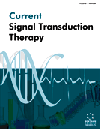- Home
- A-Z Publications
- Current Signal Transduction Therapy
- Previous Issues
- Volume 19, Issue 1, 2024
Current Signal Transduction Therapy - Volume 19, Issue 1, 2024
Volume 19, Issue 1, 2024
-
-
The Effect of Transcranial Photobiomodulation for Motor Performance Improvement in Patients with Brain Disorders
More LessAuthors: Milad Iravani, Abbas E. Kalan, Maryam Moghaddam Salimi and Ali JahanBackground: Transcranial photobiomodulation (PBM) therapy has emerged as a promising alternative therapeutic option for the management of neurological and psychiatric disorders. However, the underlying mechanisms of PBM therapy and its effects on motor performance in brain disorders are not yet fully understood. The aim of this literature review is to provide a more detailed and evidence-based explanation of Read More
-
-
-
The Effect of Silencing MiR-4270 on Apoptosis in HCC Cell Line
More LessBackground: Hepatocellular carcinoma (HCC) is the most common type of cancer. Although HCC treatment has greatly improved over the past few decades, patient survival rates are still very low. Therefore, it is essential to find new treatments for HCC. Apoptosis has been shown to be the most effective in disrupting cancer growth. Improper functioning of proteins in apoptosis can lead to cancer growth. MicroRNAs (miRNAs) are Read More
-
-
-
Exploring the Evolving Significance of lncRNA TUG1-mediated Signaling Pathways in Breast Cancer
More LessBreast cancer is one of the most common malignancies in women worldwide. Invasive ductal carcinoma (IDC) and invasive lobular carcinoma (ILC) are the most common kinds of invasive breast cancer. Several genetic, epigenetic, and environmental factors could trigger the pathogenesis of breast cancer. Breast cancer treatment generally includes surgery, radiation therapy, chemotherapy, hormonal treatment, targeted the Read More
-
-
-
Discovery of β-carboline based Derivatives through Computational Aid for the Treatment of Leishmania
More LessAuthors: Asifiwe Mwamafupa, Pinky Arora, Jagtar Singh, Kriti Seksaria and Shubham KumarBackground: Leishmaniasis is a phagocytic host cell invading, caused by leishmania species mostly found in developing nations. To treat leishmaniasis, a wide range of medications and potential vaccines are available, such as pentavalent antimonials, amphotericin, and miltefosined, but due to the lack of effective treatments, the high toxicity of chemotherapy and the growth of drug resistance linked to these diseases Read More
-
-
-
Removal of Interference from Electromyogram based on Empirical Mode Decomposition and Correlation Coefficient Thresholding
More LessAuthors: M. Karuna and Sitaramanjaneya Reddy GunturIntroduction: Electromyography (EMG) signals are contaminated by various noise components. These noises directly degrade the EMG processing performance, thereby affecting the classification accuracy of the EMG signals for implementing various hand movements of the prosthetic arm from the amputee's residual muscle. Methods: This study mainly aims to denoise the EMG signals using the empirical mode decompositi Read More
-
-
-
Framework for the Classification of Facial Emotions Using Soft Computing Techniques
More LessAuthors: Sourav Maity and Karan VeerBackground: Facial emotion recognition (FER) technology is enumerated as a productive interface in several operations, which has been specifically focused on as a substitute communication path among a user and an appliance for human computer interface in the previous decade. The efficiency of the facial identification model straightaway relies on the capability of classification methods. In addition, an appropriate sw Read More
-
-
-
Therapeutic Potential of MSC-conditioned Medium: A Multifactorial Approach to Enhance Wound Healing
More LessAuthors: Amir Anbiyaiee, Shirin Azizidoost and Maryam FarzanehWound healing is a highly intricate process that involves a coordinated interplay of various cellular and molecular events. In recent years, mesenchymal stem cells (MSCs) have garnered significant attention as a promising therapeutic modality due to their remarkable regenerative properties. In addition to their capacity for direct tissue repair and differentiation, MSCs release a diverse repertoire of bioactive factors Read More
-
Volumes & issues
-
Volume 20 (2025)
-
Volume 19 (2024)
-
Volume 18 (2023)
-
Volume 17 (2022)
-
Volume 16 (2021)
-
Volume 15 (2020)
-
Volume 14 (2019)
-
Volume 13 (2018)
-
Volume 12 (2017)
-
Volume 11 (2016)
-
Volume 10 (2015)
-
Volume 9 (2014)
-
Volume 8 (2013)
-
Volume 7 (2012)
-
Volume 6 (2011)
-
Volume 5 (2010)
-
Volume 4 (2009)
-
Volume 3 (2008)
-
Volume 2 (2007)
-
Volume 1 (2006)
Most Read This Month
Article
content/journals/cst
Journal
10
5
false
en


